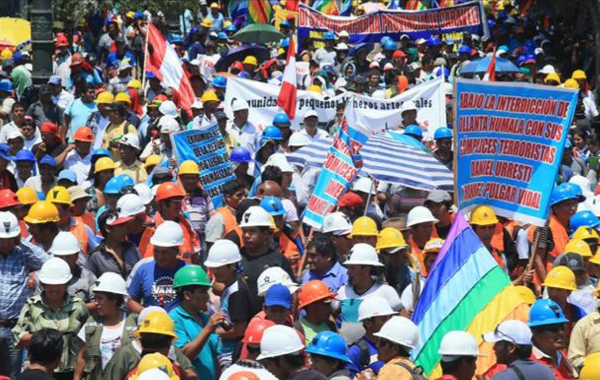
Illegal gold production in the South American nation has increased fivefold in the last six years and it is estimated to provide 100,000 direct jobs in the country.
More than 20,000 unlicensed gold miners continued to protest in Peru’s capital and various regions Tuesday, the sixth consecutive day of demonstrations against President Ollanta Humala’s crackdown on illegal mining.
The dissenters want the government to ease a regulation passed in 2012, which forces more than 70,000 miners to register their mining activities by April 19 or otherwise face sanctions, which include imprisonment.
Over the past week, the informal miners have blocked roads and even marched to the capital, requesting a meeting with the President. Humala has yielded to pressures yet; instead, has repeated the regulation is key to stop illegal mining from destroying the Amazon rain forest and affecting the health of locals, reports El Ciudadano (in Spanish).
The miners, in turn, claim they’re being treated as criminals and the clean up endangers the livelihood of thousands of families, as it would make about 400,000 artisanal operations illegal, even though they work in authorized areas.
Long-dragged battle
The truth is that for well over two years, the Peruvian government has been trying to tighten the screws on illegal mining, playing a role in an ongoing battle between illicit miners, environmental activists and local authorities.
Despite the efforts, illegal gold production in the South American nation has increased fivefold in the last six years and it is estimated to provide 100,000 direct jobs in the country, 40% of which are in the Madre de Dios region.
 The situation is mirrored in dozens of the countries, where gold is similarly mined and where the desperately poor often end up working in risky conditions.
The situation is mirrored in dozens of the countries, where gold is similarly mined and where the desperately poor often end up working in risky conditions.
According to Peru’s ministry of environment, the use of mercury and other toxic elements by illegal gold miners has already destroyed 18,000 hectares of the Amazon rainforest.
Experts say the amount of toxics generated by the use of large amounts of mercury to process gold have reached lethal levels. A recent study found that close to 80% of residents in the capital of the gold-rich Madre de Dios region have high levels of mercury in their bodies as a result of fish consumption.
More recently, the Carnegie Amazon Mercury Project revealed the levels of mercury in water resources are way higher than expected: close to five times higher than the limit considered safe by the World Health Organization (WHO), and double the safe mark in the country’s urban areas.
Peru is the world’s sixth largest gold producer, but an estimated 20% of its annual production is of unknown origin.